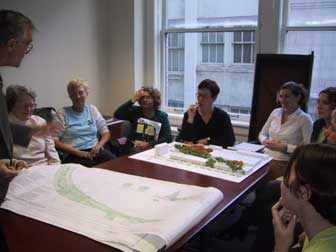
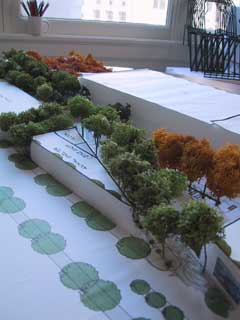
< previous table of contents next >
5. LANDSCAPING AND CULTURAL RESOURCES
The swath of land preserved by the railroad provides a physical memory of Mission Creek, which today flows in sewer culverts beneath Division Street (see appendix K). There are few remaining indications that a river once flowed here, with a major railroad from San Jose built along its shores. This concept plan proposes to provide both an attractive bicycle/ pedestrian facility, and also frequent reminders of what was lost when the area was industrialized. One of the primary methods to accomplish this goal is the restoration of natural features, including plant and tree species (see Appendix F).
Softening the harsh environment in this industrial area through the creation of open spaces and landscaping will encourage more people to get out of their cars and use the Bikeway for transportation. Open space will also provide appropriate settings to highlight historical and cultural information about the former river and railroad, and how the character of the area has changed during different periods of San Francisco's history.
In this era of increasing concern and awareness of the need to protect our environment, highlighting the river corridor becomes a powerful mechanism to remind people of the water flowing to the Bay beneath our feet, and the need to reduce the toxic pollutants we dump onto our streets through everyday use of the automobile. Educational kiosks are planned along the route, which provide historical references and environmental education messages.
Numerous opportunities for "pocket parks" exist along the route. A string of small green spaces are much easier to fund and maintain than one large city park facility. Two such green spaces have been proposed and adjacent private property owners have indicated a willingness to maintain these and keep them open to the public. One at 9th and Division would be on a corner of City property in front of Dolby Labs; the other is at the corner of Vermont and Division, owned by Bay West Group (the Showplace Design Center). The extent of improvements is yet to be determined. Bay West Group already maintains the public landscaping in the center of Townsend circle.
A Caltrans parcel at Division and San Bruno is another good candidate for open space, which would need a responsible entity to maintain it. Another location for landscaping is at the entrance to the Bikeway at Harrison, where an underutilized section of Treat Avenue is proposed to be abandoned for automobiles and improved with a bikeway and pocket park. The San Francisco League of Urban Gardeners (SLUG), part of SF DPW, has expressed interest in participating in the Mission Creek landscaping project.
Avenida del Rio
Avenida del Rio is the name of the coordinated art & education project envisioned for the Bikeway by the Madrina Group. Funding will be solicited and art projects will be selected with a theme or message for different sites, within the larger river context. For example, the two sites where bridges once crossed the river should contain some reference to those bridges. At the 16th and Harrison bridge site is located the SF Animal Shelter with the SPCA across the street. Individuals from these organizations responded enthusiastically to the "bridge" metaphor, since they see their work together as something of a "bridge" for the animals that find themselves at the Animal Shelter needing a new home.
In 1999 the Madrina Group commissioned a mosaic tile mural depicting Mission Creek, which was installed at the corner of 16th and Harrison, where a bridge once crossed the river. (The mosaic mural on the title page was inspired by the drawing in Exhibit 2 on page 3) This piece of public art has brought awareness of the river to thousands of people passing the site, including bicyclists who use the existing SF Bike Routes #33 & 25 along Harrison.
The drawbridge once located where Potrero crossed the river to Brannan is another location where it is hoped that educating the public of the area's history will have more than aesthetic benefits. With the knowledge that this site has always been a difficult passage, and that a navigable waterway once flowed along Division, it is hoped to help ease the frustration drivers feel with the delays at this massive and confusing intersection.
A Mission Creek Museum is proposed for a small metal building at the entrance to the Bikeway, on the corner of 15th St and Treat. The property is owned by SF Hetch Hetchy Power & Light and used currently to store truck tires by MUNI. The SF PUC (of which HHP&L is a part) is preparing a billion dollar capital improvement program to the City's wastewater system and the MCB Project Team will be requesting this small building be contributed to a water-pollution prevention education program as a part of their capital project.
UC Berkeley Extension Planting Design Course Fall 2001


The University of California at Berkeley Extension Planting Design Class presents their work at Rails-to-Trails Conservancy, including this scale model of Treat Ave. by Claudia Olalla and Lisa Charpontier.
The MCB planning team was lucky to be able to benefit from the work of Vince Healy's Fall 2001 UCB Extension Planting Design Course. The class was divided into teams and directed to create landscaping plans for the section of the MCB on Treat Avenue between Harrison and Bryant (selections from the class's work are included in Appendix G and on the following pages). Some of the concepts that the students expressed in their designs included:
Native species of plants and trees that would be suitable for the local microclimate were selected, and planting designs were presented at the end of the course. Species selections from the class are included in Appendix F.
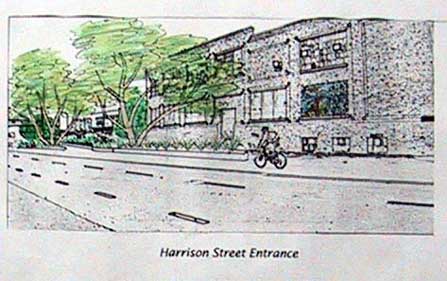
Exhibit 20: Landscape Design Idea for 16th and Harrison Bikeway Entrance by Rick Morris
One of the students from the class, Kap Seidel, was retained to prepare the initial design concept for the project, which includes cross-sections and conceptual drawings. At the time when this plan was prepared, the project team was still seeking to implement a Class I bikeway along the length of Treat, reflected in the Initial Design Concept. Subsequent developments ruled out such a facility along Treat, and the current Class III bicycle boulevard was adopted. This initial design concept is included as Appendix E.
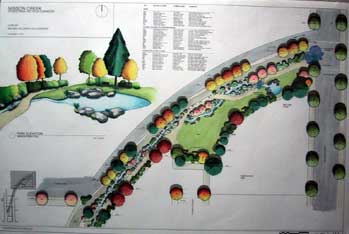
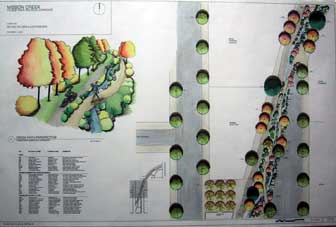
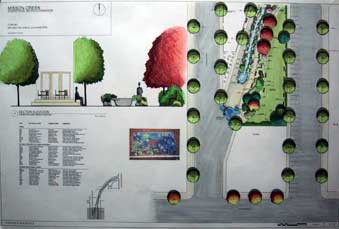
Exhibit 21: Landscape Design Trilogy (Melissa Willman and Julia Sanders)